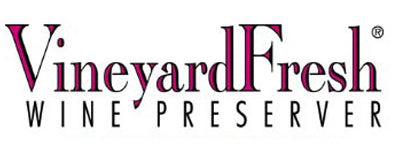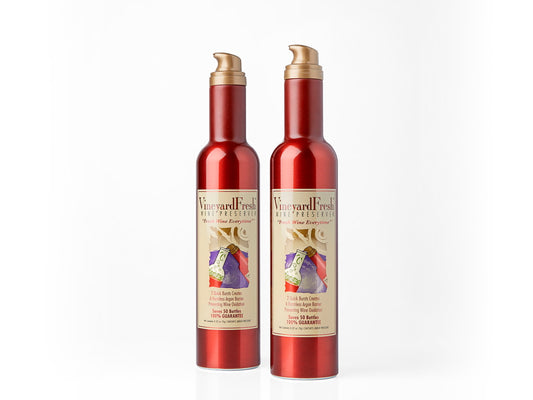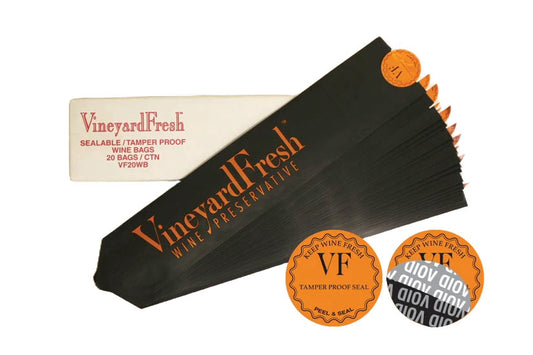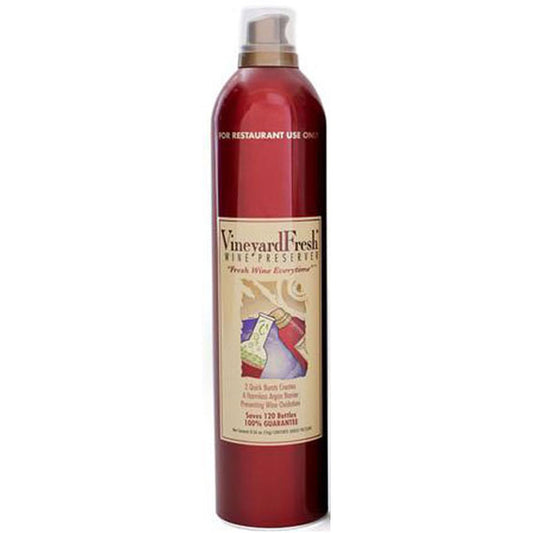FAQs
Beyond the frequently asked questions we list below, we also have a ton of additional information over on our VineyardFresh News Blog. In addition, click the search icon up top and search for any other topic you may be interested in. Don't see an answer to your question? Send us an email so we can add it!
How does VineyardFresh Wine Preserver preserve open bottle of wine?
VineyardFresh is 100% food grade argon - a noble gas that is heavier than air. VineyardFresh, when sprayed into the bottle, settles directly on top of the surface of the wine and creates a natural protective barrier between the air and wine. This protective layer prevents the wine from oxidizing. Learn more about How VineyardFresh Preserves Wine.
Will VineyardFresh Wine Preserver harm my wine?
Absolutely not. Argon is 100% pure and natural - it's in the air we breathe. VineyardFresh does not penetrate into wine and is colorless, tasteless, and odorless. Not only is Argon 1% of the air we breathe, it's the same wine preserver process used by professional wineries around the world. Learn more about The Science Behind Argon Wine Preservation.
How long will VineyardFresh Preserve my wine?
VineyardFresh Wine Preserver will keep wine fresh for days, weeks, and even months. If your skeptical, check out our test results that prove VineyardFresh prevents oxidation and keeps wine tasting fresh. Remember - you still need to store the bottle in a cool, dark place to prevent the wine from getting hot and sitting in direct sunlight.
Why Does Wine Go Bad?
Wine goes bad due to light, heat, and exposure to oxygen. Avoid leaving bottles in bright light and warm locations to handle the first two issues. As for the third - exposure to oxygen - you're fine until you open the bottle. Then, the clock begins ticking. Over time, the wine will oxidize, degrading the fresh taste. VineyardFresh stops oxidation, keeping open bottles of wine tasting fresh.
How many bottles of wine will I be able to keep fresh with a single canister?
Each consumer size canister of VineyardFresh will have a minimum of 50 applications (two bursts per application). The larger On Premise / Institutional size VineyardFresh will save 120 bottles of wine.
Why does VineyardFresh canister feels so light and how will I know when it is empty?
VineyardFresh is 100% Argon gas. Argon is 1% of the air we breathe, so it's very very light and that makes a full can feel empty. It's even why we print "FULL CAN FEELS EMPTY" on the back of every can. You'll know the can is empty when you tilt the nozzle and it stops hissing. However, if you feel or hear VineyardFresh coming out of the can, it's still working. See our article "How do I Know When My Can is Empty" for more info.
Is VineyardFresh as Good as Coravin?
The Coravin is a nice wine preservation system. They're beautiful, allow you to not pull the cork, and are a great solution for infrequently accessed high end wines.
But, Coravin is not the right solution for fast paced on premise environments, where time, labor, and ease of use are critical elements for effective wine preservation. See our article "VineyardFresh vs Coravin - Which is the Better Wine Preserver for Your Business."
Can restaurants use wine preservation for their "wines by the glass" programs?
Yes! Absolutely. This is a great wine revenue opportunity for restaurants. VineyardFresh is already used in many restaurants, hotels and private clubs to ensure each glass they serve tastes fresh. Our goal is to expose more restaurant professionals to how they can increase wine revenue by using wine preservation to expand their wine by the glass offering.
How Much Does it Cost to Preserve Wine?
For consumers, it costs around $0.30 to save a bottle of wine at home. For on premise operators, who can buy the larger Restaurant Size can at a wholesale price, the cost to save a bottle can drop to below $0.10 per bottle.
VineyardFresh is an extremely cost effective method to preserve wine. Compared to devices and cabinets, the cost per bottle saved is orders of magnitude cheaper and easier to implement. See our article "How Much Does it Cost to Preserve Wine in Your Restaurant?"
What makes VineyardFresh better than other wine preservers?
VineyardFresh Wine Preserver, using 100% argon, is the preferred method to preserve wine because it is based on good science. VineyardFresh is very easy to use and is proven effective in stopping oxidation. See our article on "The Top Ways to Preserve Wine" for more comparisons.
Vacuum products attempt to remove the air between the wine and the cork. But vacuum devices can only remove a fraction of the air, therefore most of the oxygen remains in the bottle. This is what causes oxidation.
Unfortunately, you can't create enough of a vacuum to stop the oxidation process. A second issue with vacuum systems is that many wine experts dislike the fact that vacuums "pull out" the bouquet or aromas in wine. 70% of enjoying wine is in the smell (that is why we swirl the glass, to release the aromatics while tasting). The term "flattening" the wine by pulling out the aroma and bouquet is often used when critiquing vacuum devices. See this article "Vacuum Pumps Suck by Design and Poor Science."
What about wine preservers that use other gases, like carbon dioxide or nitrogen?
Carbon dioxide is not an inert gas and will react with the wine. Carbon dioxide reacts with the water in the wine and forms carbonic acid - affecting the flavor and giving the wine a metallic taste.
Nitrogen unfortunately is lighter than oxygen and therefore doesn't fall into the bottle to create the protective blanket on top of the wine. Nitrogen will work in a "closed system", where all of the oxygen is replaced by Nitrogen. This type of preservation method typically appears in large cabinets or installed systems you'd find in a wine bar or grocery store.
There are certainly other wine preservers that use 100% argon. Most are typically more expensive to buy and operate, while argon canisters like VineyardFresh offer a very low cost and easy to use wine preservation system that requires no capital expense.
Does VineyardFresh preserve other things?
Yes. Any liquid that is stored in a bottle and prone to oxidizing. For example, vintage port, sherry, single-malt Scotch, sake, and even cooking wines can all benefit from using VineyardFresh to stop oxidation. Another major culinary use is higher end specialty cooking oils. Keep oils fresh by keeping them out of sunlight, in a cool space, and preserved with VineyardFresh.
Buy VineyardFresh
VineyardFresh is one of the original 100% Argon wine preservers - protecting wine since 1999. Start using VineyardFresh Wine Preserver to:
- Enjoy better tasting wine at home
- Serve better tasting wine on premise
- Increase your wine revenue at your restaurant, wine bar, country club
- Open whatever bottle of wine you want, when you want!
-
VineyardFresh Wine Preserver | 100% Argon Wine Preserver Spray | Consumer Size Can
Regular price From $ 29.95 USDRegular priceUnit price / per$ 36.95 USDSale price From $ 29.95 USDSale -
Take Home Tamper Proof Wine Bags - For "Wine to Go" Programs (Pack of 20ea)
Regular price $ 30.00 USDRegular priceUnit price / per$ 30.00 USDSale price $ 30.00 USDSold out -
VineyardFresh Wine Preserver | 100% Argon Wine Preserver Spray | On Premise Size Can
Regular price From $ 44.95 USDRegular priceUnit price / per$ 44.95 USDSale price From $ 44.95 USDSold out
Learn More About VineyardFresh
View all-

How Wine Preservation Can Boost Your Restaurant...
As a restaurant owner or manager, you’re always looking for ways to increase revenue while keeping costs under control. One often-overlooked opportunity? Wine preservation.
How Wine Preservation Can Boost Your Restaurant...
As a restaurant owner or manager, you’re always looking for ways to increase revenue while keeping costs under control. One often-overlooked opportunity? Wine preservation.
-
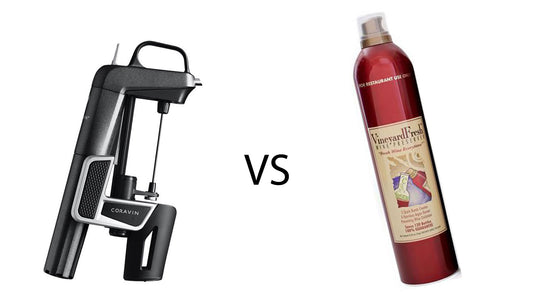
VineyardFresh vs Coravin - Which is the Better ...
We know 100% Argon is the best wine preservation method. VineyardFresh uses 100% Argon to preserve wine. So, which one is the better choice for you to use to preserve...
VineyardFresh vs Coravin - Which is the Better ...
We know 100% Argon is the best wine preservation method. VineyardFresh uses 100% Argon to preserve wine. So, which one is the better choice for you to use to preserve...
-
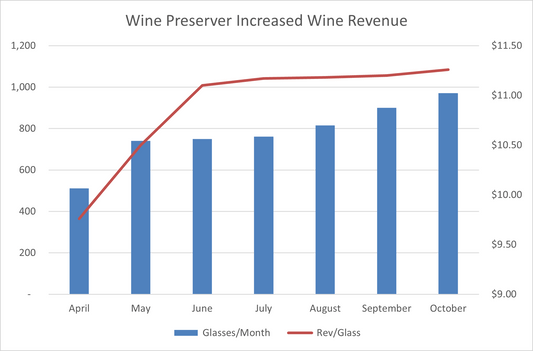
Sell More Wine, Increase Wine Revenue and Profi...
When you use an argon wine preserver in your restaurant, wine bar, or tasting room, you will increase wine revenue and profits. First, you can use wine preservation as a...
Sell More Wine, Increase Wine Revenue and Profi...
When you use an argon wine preserver in your restaurant, wine bar, or tasting room, you will increase wine revenue and profits. First, you can use wine preservation as a...
